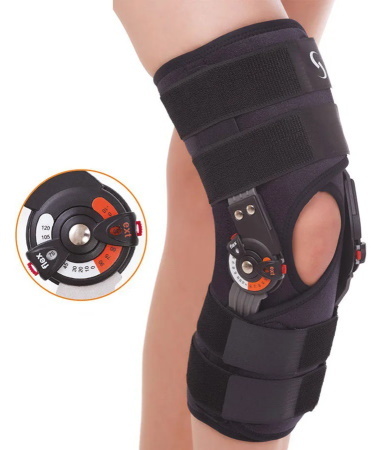Content
- Appointment of the knee brace
- Product design
- Brace types
- Functional
- Rehabilitation
- Patellofemoral
- Preventive
- Contraindications to wearing
- Criterias of choice
- Appointment
- Materials (edit)
- The size
- Production technology
- Design
- Hardness level
- Wearing precautions
- Care of products
- Manufacturers and prices
- Knee Brace Videos
The knee brace is special orthopedic constructions, which are used for the complex treatment and prevention of diseases of the musculoskeletal system. Each type of this device has its own functional purpose. Braces are used by athletes to prevent injuries of the lower extremities, are prescribed for children and adults during the period of postoperative or post-traumatic rehabilitation.
The selection of this type of orthopedic design is carried out taking into account the individual characteristics of the anatomical the structure of the patient's knee joint and the type of pathology that caused a painful condition of the musculoskeletal apparatus.
Appointment of the knee brace
The knee brace is a removable mechanical device designed to fix and maintain joints in position. This orthopedic design allows you to control every movement of structural elements knee, prevents its displacement, injury or dislocation under the influence of external and internal factors.
The main purpose of the braces is to implement the following functions and tasks:
- redistribution of physical activity to the knee joint;
- keeping this part of the leg in the same position even at the moment of performing active movements;
- shortening of the healing period of bone and connective tissue of the joint after severe trauma or surgery;
- protection of the knee surface from mechanical damage (for example, while skiing, motorcycle, bicycle);
- prevention of the development of the inflammatory process inside the joint during the period of intense physical exertion on the lower extremities.
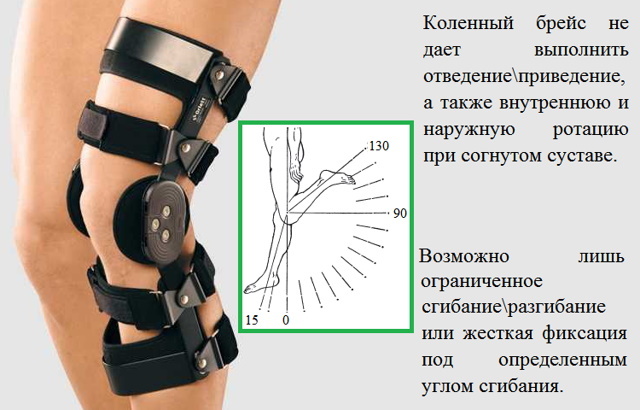
The use of knee braces is indicated for children, adults and elderly people who have injuries, acute and chronic diseases of this part of the musculoskeletal system. The selection of an orthopedic structure is carried out by the attending traumatologist, surgeon or orthopedist based on the results of a comprehensive examination of the patient.
Product design
The knee brace is a complex mechanical structure that consists of metal and polymer materials. The table below lists the components included in the orthopedic products of this type.
| Knee brace design | Functional purpose of the connecting element |
| Liners | The sleeves are a structural part of the brace that is attached to the right and left sides of the knee joint. These elements provide a sufficient level of rigidity of the orthopedic structure, provide reliable fixation of the lower limb. |
| Stoppers | Stoppers maintain the mobility of the mechanical structure within the specified parameters. This element of the orthosis can be adjusted depending on the functional state of the patient's knee joint. |
| Belts and Velcro | Straps and Velcro fasten the braces, provide them more reliable and tight fixation on the surface of the lower limb. Due to these fasteners, the orthopedic structure is held on the leg. |
| Locks | The brace locks are responsible for the synchronization of movement of the lower limb and the activation of all structural elements of the orthopedic design. At the moment of performing active movements, the patient does not experience discomfort due to the fact that a mechanical device is put on his knee. |
The knee brace may have slight differences in the connecting elements of the orthopedic design. Some types of orthoses of this type are made to order, taking into account the functional state of the patient's knees.
Brace types
There are several types of knee braces, which have different purposes, perform a therapeutic function, are used to prevent diseases, protect the musculoskeletal system from injury or accelerate the recovery process bone tissue.
Functional
The functional brace is a rigid or semi-rigid base orthopedic that is designed to be worn for a long time. A person with a knee injury moves in this type of orthopedic structure until the joint will not be able to independently perform the physiological functions of flexion and extension of the lower limbs.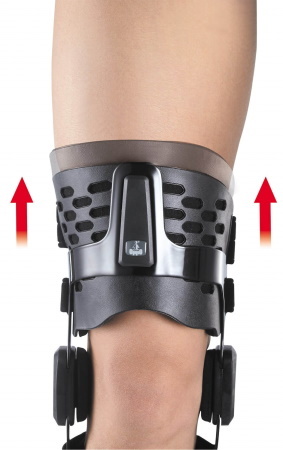
Depending on the nature of the injury or the current disease of the musculoskeletal system, functional braces of a standard type, or they are custom-made for a specific the patient.
Functional braces are designed to ensure tight fixation of the knee joint with its immobilization on throughout the entire course of drug therapy or until the end of the period of post-traumatic, postoperative rehabilitation.
The advantage of using functional type orthopedic structures is the reliability of their connecting elements, preservation of the physiological activity of the remaining parts of the lower limb, exclusion of the factor of atrophy or decrease in skeletal tone leg muscles.
During the period of wearing this orthosis, the knee joint is simultaneously restored and developed without creating intense physical activity.
Rehabilitation
The knee brace, which is used for the rehabilitation and recovery of the lower limb, has a rigid, semi-rigid or elastic base. Orthopedic products of this type are prescribed for children, adult men and women, as well as people the elderly who have suffered a severe knee injury or have undergone surgery on their joint operation.
Rehabilitation braces can be used for patients who have undergone medical therapy for acute inflammation of the knee joint. The period of wearing this orthopedic structure is determined by the attending surgeon, traumatologist or rehabilitation therapist.
Patellofemoral
Braces of this type are designed to stabilize the functions of the knee joint and support its structural elements at the time of performing active movements of the lower limb. The patellofemoral orthosis has a number of design differences.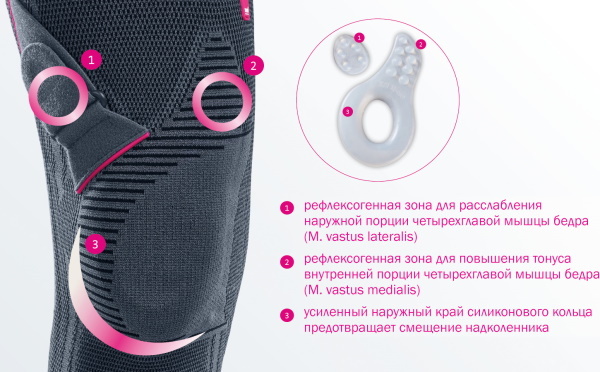
This type of brace creates special conditions for the knee joint. After their fixation on the surface of the leg, smooth mobility of the patella is ensured. The patellofemoral orthopedic construction is indicated for use in patients with chronic pain in the knee joint, recurrent inflammatory and degenerative processes.
Preventive
Prophylaxis braces are a separate type of knee orthoses that are designed to prevent injuries of varying severity. The orthopedic design is put on the surface of the lower limb before the start of the sports training, performing exercises that involve the creation of intense physical activity on your feet.
Prophylactic braces can be equipped with additional structural elements in the form of knee pads, or they have a more rigid base on the right and left sides. Protective orthoses are popular among hockey players, skiers, snowboarders, weightlifters.
Contraindications to wearing
Knee braces are prescribed only after a preliminary examination of the patient.
The use of orthopedic structures of this type is contraindicated in the following cases:
- varicose veins, regardless of the stage and severity of the pathological process;
- paralysis of skeletal muscles caused by damage to peripheral nerves, brain diseases or the consequences of a stroke;
- individual intolerance to the body of the materials from which the orthopedic construction is made (in this case, the patient shows signs of an acute allergic reaction in response to contact of the skin of the lower limb with the surface brace);
- history of thrombophlebitis;
- the presence of wounds, abrasions, trophic ulcers and other damage to the skin in the area of contact with the surface of the orthosis;
- dermatological diseases of the lower extremities, accompanied by an inflammatory process (in a similar situation you will have to undergo a course of therapy to restore the health of epithelial tissues, and only then use the braces in medical purposes);
- oncological and benign tumors inside the knee joint.
The use of knee braces is contraindicated in people who have impaired local blood circulation in the tissues of the lower extremities. Fixation of a rigid orthopedic structure will exacerbate the pathological condition of the blood vessels in the lower leg and foot. This can cause the development of varicose veins and thrombophlebitis.
Criterias of choice
In the process of choosing braces for the knee joint, the functional state of the lower limb is taken into account of the patient, the type of underlying disease, as well as the purpose of acquiring an orthopedic structure of this type.  Based on these parameters, an orthosis is selected with an appropriate level of rigidity, quality of materials and design features.
Based on these parameters, an orthosis is selected with an appropriate level of rigidity, quality of materials and design features.
Appointment
The intended use of the knee brace should be determined solely by the orthopedic specialist. Products of this type are prescribed by a doctor for daily wear, or they are used only at the time of physical exertion on the bone and connective tissue of the lower extremities.
For people with chronic diseases of the knee joints, which periodically turn into a state of exacerbation, the use of functional and patellofemoral braces is indicated. Patients who are at the stage of rehabilitation therapy, have undergone medical or surgical treatment of their knees, are prescribed daily wearing of rehabilitation orthoses.
Athletes who exercise on the muscles of the lower extremities are advised to wear sports braces that protect the knees from injury. Depending on the intended purpose of orthoses, the appropriate parameters of their structural elements are selected. For example, braces are purchased with a special fastening mechanism, connecting parts, stronger locks, or a reinforced plate to reliably protect the kneecap.
The height of the product is also adjusted for the intended purpose of the prosthetic. Prophylactic braces should be purchased for people who have previously suffered a knee injury or have been successfully treated for a particular joint disease. Wearing this type of orthosis will minimize the risk of recurrence.
Materials (edit)
The fixing part of the brace is made of metal components. The lightweight version of the orthopedic construction contains neoprene elements. It is a synthetic rubber that is characterized by high strength, shockproof properties, but at the same time very lightweight, comfortable for daily wear.
The rest of the components of the knee brace are made of elastic fabric, polymer and metal materials depending on the type of product, its intended purpose and degree of rigidity. Orthopedic structures, which are made to order, may contain connecting elements from various alloys.
The size
The selection of the knee brace is carried out after taking measurements of the joint circumference. Based on the obtained parameters, the choice of an orthopedic construction with the corresponding diameters and height of the fixing part is carried out.
Too small an orthosis will cause discomfort, its attachments will squeeze soft tissues, pinch blood vessels. Over time, this will lead to the development of concomitant diseases. A large brace will not provide a secure fit for the knee, which means there is no therapeutic or prophylactic effect.
Production technology
Before buying a knee brace, you need to decide which product is appropriate to use in a particular case.
Individual production technology allows us to produce the highest quality orthopedic construction for the creation of which measurements are taken from the patient's lower limb, taking into account the anatomical features of the joint and the type diseases.
The purchase of a serial production brace means the purchase of an orthosis that is made on the basis of standard templates.
Design
When choosing a knee brace, an important criterion must be considered regarding the distinctive features of the prosthetic design. There are hingeless products that outwardly resemble a regular bandage.
These braces have an average level of rigidity, are suitable for use in preventive and rehabilitation purposes, but subject to a stable state of the structural elements of the knee joint.
The disadvantage of hingeless braces is that they do not sufficiently immobilize the knee, and also do not properly distribute physical activity during active movements. Hinge structures are more practical because special hinges are used during their production. Components of this type connect the braces of the orthosis, which give the product greater strength, reliably fix the knee joint in a given position.
Hardness level
The compressive force of the brace in relation to the knee joint is one of the key criteria to be considered when choosing this product. The table below lists the main degrees of rigidity for this type of prosthetic.
| Stiffness level of the knee brace | Product characteristics |
| Soft | This type of brace is quite tightly in contact with the knee surface, adapting to the peculiarities of its anatomical structure. The fixing base of this product can be made of strong elastic fabric. Soft braces are most often prescribed to patients for the prevention of injuries and faster rehabilitation after treatment. |
| Semi-rigid | Semi-rigid knee braces are orthoses that are made from durable materials and contain a large number of metal components. Orthopedic splints of this type are made of polymer materials that are resistant to deformation and damage. During active movements, the semi-rigid brace does not change the shape of its structure. |
| Hard | All rigid knee braces are equipped with a maximum number of metal inserts, which are complemented by extra strong plastic parts. These orthoses reliably fix the joint, preventing the creation of physical stress on its structural elements. |
As the function of the knee joint is restored, the attending physician selects braces with a lower level of stiffness. An orthopedic product that squeezes the knee too much negatively affects the health of the bone and connective tissue of the lower limb.
Wearing precautions
The following precautions should be taken while wearing the knee brace:
- always check the reliability of fixation of the product on the surface of the lower limb;
- do not independently adjust the level of rigidity of the orthosis;
- pay attention to the level of comfort while performing active movements (discomfort in the knee area may indicate improper fixation of the brace);
- monitor the condition of the tissues in the circumference of the joint (there should be no swelling, bruising, swelling and signs of irritation).

The brace should fit snugly against the surface of the knee joint. While wearing the orthosis, it is not allowed that its fasteners weaken their fixing effect on the tissues of the lower limb.
Care of products
The knee brace will gradually wear out due to frequent wear and exercise.
To prolong the life of this product, we recommend that you follow the following care guidelines:
- Do not wash the brace in hot water or detergents with aggressive acidic or alkaline bases.
- Wipe plastic parts of the orthopedic construction with a damp cloth.
- Dry the braces at room temperature, and the product itself should be in an upright position and straightened out.
- Do not allow the orthosis to fall from a great height.
- Do not expose the product to mechanical stress.
- Wash fabric elements of the product in water with a temperature not higher than +20 degrees Celsius.
In case of suspicion of a malfunction of the orthopedic structure, it is necessary to seek help from the attending physician who prescribed the wearing of this brace, and also helped in its selection.
Manufacturers and prices
There is a huge selection of knee braces for different types and purposes.
Most orthopedic products of this type are manufactured by the following companies:
- BREG (USA);
- ORTO (Russia);
- FOX (USA);
- Townsend (USA);
- OTTO BOCK (Germany);
- ORLET (Germany);
- EVS (USA).
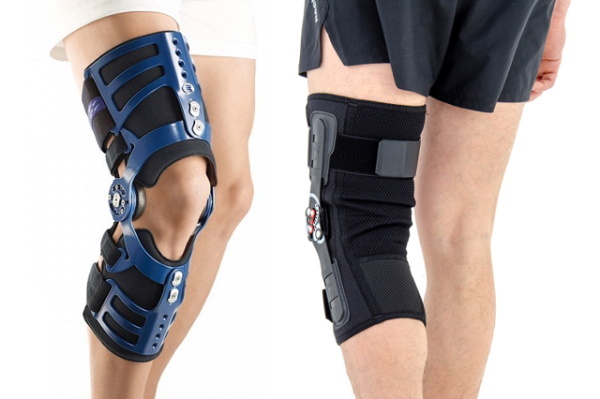
Knee brace
The average cost of knee braces ranges from RUB 6,040 to RUB 18,000. depending on the quality of the material, component parts of the structure, the functional purpose of the orthosis.
A knee brace is a modern type of orthosis that is worn over an injured or painful joint. Orthopedic construction of this type is designed for reliable fixation of the lower limb, reducing the level of physical activity on the structural elements of the joint at the time of performing active movements.
According to their intended purpose, knee braces are classified into functional, rehabilitation, prophylactic and patellofemoral. The type of orthosis is selected by a traumatologist, orthopedist or surgeon after a preliminary examination of the patient. The knee brace is contraindicated in patients with chronic blood vessel disease in the lower extremities.
Knee Brace Videos
Knee stabilization brace:

